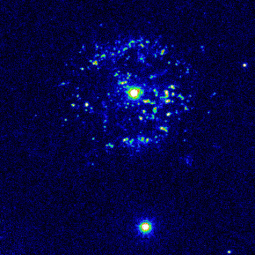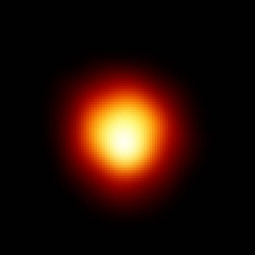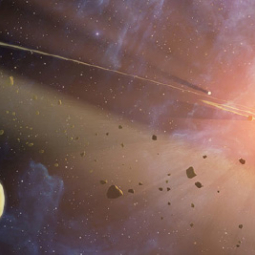Science results from NASA’s Stratospheric Observatory for Infrared Astronomy were featured in a special session held at the American Astronomical Society’s annual meeting, Jan. 8, 2016, in Kissimmee, Florida. The airborne observatory reached full operational status in May 2014; the fruits of its early science programs are beginning to be available to the scientific community.
“SOFIA’s first dedicated science session presented the opportunity to showcase a variety of research projects by a geographically diverse group of astronomers,” said Pamela Marcum, SOFIA project scientist. “These results demonstrate that SOFIA and its suite of instruments are capable of producing world-class observations ranging from interstellar dust grain analyses to planetary occultation measurements to studies of astrochemical spectra.”
The special session gave astronomers who are preparing to submit their research for review an opportunity to discuss their observations with a national and international audience of scientific professionals.
Principal investigator Bob Gehrz, University of Minnesota, used SOFIA’s Faint Object infrared CAmera for the SOFIA Telescope (FORCAST) to study novae, which are thermonuclear explosions that occur on the surfaces of stellar remnants. This research, entitled “SOFIA/FORCAST Grism Spectra of Classical Novae,” focused on the role novae play in creating and injecting elements into the interstellar medium. These SOFIA/FORCAST spectroscopic observations found high abundances of elements such as carbon, nitrogen, oxygen, neon, magnesium, aluminum, and silicon in the debris clouds expanding away from several recent bright novae. Some of those elements are major constituents of living things, and others are major components of Earth-like planets, These researchers conclude that nova eruptions are a significant source of those elements in the Universe. Portions of this research project were recently published in the Astrophysical Journal : Gehrz et al. 2015, Ap.J. 812, 132.
Graham Harper from the University of Colorado discussed his research “Probing the Extended Atmosphere and Wind of Betelgeuse with SOFIA-EXES: Exploiting the Forbidden Fe II Ladder,” detailing his study the famous star, Betelgeuse. Betelgeuse is a massive star (about 20x the mass of the Sun) that is in the red supergiant evolutionary phase, nearing the end of its life before exploding as a supernova sometime in the next million years. Harper and his collaborators are studying Betelgeuse’s rapid mass loss via a strong outflow (“stellar wind”). The mechanism driving the outflow is not understood for Betelgeuse compared with outflows from other stars in different life stages. That mass loss is interesting both because the material is being recycled into the interstellar medium, and because measuring it allows a better estimate of when Betelgeuse will eventually explode. Only SOFIA and the Echelon-Cross–Echelle Spectrograph (EXES) had access to the needed mid-IR wavelengths with high enough spectral resolution to fully investigate this question. Further details from Graham Harper’s talk were reported in the online edition of the journal Nature .
Researchers led by Kate Su of the University of Arizona studied the planetary debris disk around the nearby solar-type star Epsilon Eridani. That star is approximately 1 billion years old, a main sequence star long past the protostellar stage, so the disk is understood to be leftover debris from an already-completed planetary system rather than a protoplanetary disk involved in current planet formation. Su’s investigation, “Nature of the Warm Excess in eps Eri: Asteroid belt or Dragged-in Grains,” seeks to distinguish between two substantially different models of this system, one in which the planetary material is distributed in multiple bands (asteroid or comet belts) separated by gaps, versus the other model in which the material is distributed more evenly across the disk without gaps. Preliminary results from analysis of the SOFIA data support the “bands and gaps” model. Researchers hypothesize that such gaps are likely delineated by the orbits of nearby planets.
Concluding the special science session was Michael Person from MIT who discussed “Pluto's Atmosphere from the 29 June 2015 Occultation: SOFIA Airborne Results,” detailing his team’s analysis of their Pluto occultation data. The June 2015 Pluto transit was a target of opportunity for the observatory, which was operating in the Southern Hemisphere, from Christchurch, New Zealand, enabling the SOFIA telescope with its four detectors to be positioned deep within the central-flash region of the occultation. The SOFIA data was combined with other ground-based observations to determine the properties of Pluto’s lower atmosphere, providing measurements complementary to the New Horizons spacecraft’s July 2015 measurements of Pluto’s upper atmosphere. Pluto is a small and cold object, so the persistence over decades of this atmosphere is somewhat of a puzzle that may be explained by surface images showing signs of relatively recent geologic activity.
“We’re looking forward to February 2016 when SOFIA’s year-long observing Cycle 4 will begin,” said SOFIA Observatory Director Erick Young. “The U.S. and German scientific communities have been awarded more than 580 hours of observing time in Cycle 4, and we will begin soliciting proposals for Cycle 5 in May of this year. The addition of SOFIA’s eighth instrument, the High-resolution Airborne Wideband Camera-plus (HAWC+), will give unprecedented access to the infrared spectrum, enabling our users to study wavelengths out to 235 microns.”
A directory of SOFIA scientific publications can be viewed here .
The SOFIA program is a partnership of NASA and DLR. NASA's Ames Research Center located in Moffett Field, California manages the SOFIA science mission in cooperation with USRA, located in Columbia, Maryland, and DSI, located in Stuttgart, Germany. The SOFIA aircraft is based at the NASA Armstrong research aircraft operations facility in Palmdale, California.
Points of Contact
Nicholas A. Veronico
SOFIA Science Center, NASA Ames Research Center, Moffett Field, Calif.
650-224-8726
nicholas.a.veronico@nasa.gov
/
nveronico@sofia.usra.edu
Dana Backman
SOFIA Science Center, NASA Ames Research Center, Moffett Field, Calif.
650-604-2128
dbackman@sofia.usra.edu
/
dbackman@seti.org



